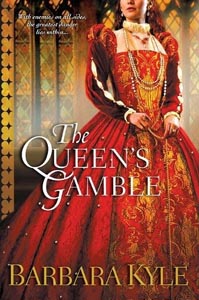Welcome to On the Tudor Trail Barbara! Could you share with us a little about yourself and your background?
Thanks, Natalie. I’m delighted to be your guest.
To give you a little about my background, I grew up near Toronto and attended the National Theatre School of Canada. I was an actor for twenty years on TV and stage before I became an author, and that was the best experience for writing. It gave me a bone-deep sense of dramatic structure, which is fundamental to creating great stories.
I’m married to a wonderful “Renaissance man” and we have one daughter.
Why does the Tudor period capture the imagination of so many authors of historical fiction?
I’d say it’s because of the larger-than-life people who were the movers and shakers of the time, from the monarchs, especially Henry VIII and Elizabeth I, to Henry’s wives, to wily politicians like Wolsey, Thomas Cromwell, and Sir Thomas More. I feature More, a fascinatingly complex person, in The Queen’s Lady.
But I think authors, and readers too, love the period most because it shines with powerful, and very willful, women: Catherine of Aragon and Anne Boleyn, Elizabeth I, Mary I, and Mary Queen of Scots. There has never been a period, before or since, that was so dominated by female rulers. All of the queens I just mentioned feature in my four “Thornleigh” novels.
When did you first become interested in this period of history?
I’d always loved it from acting in the plays of Shakespeare during my career in the theatre. But also, later, there was an epiphany moment. I saw an exhibition of the drawings of Hans Holbein of the people in the court of Henry VIII. It was on tour in Toronto, on loan from the Windsor Castle collection. The men and women Holbein drew looked so lifelike, so real, I almost thought they might open their mouths and complain about the weather.
What was the inspiration behind your ‘Thornleigh’ series?
Again, it was those Holbein drawings. One was of Sir Thomas More and his family. I started to read about him and was fascinated. He was a brilliant writer and a loyal friend of Henry VIII until the crisis over Henry’s divorce. And, rather unusually, More educated his three daughters on an equal footing with his son, teaching them Latin and Greek, mathematics and theology. But I was drawn to the complexity of the man, because while he was a loving family man he was also, as chancellor of England, a religious zealot who banned books and burned men at the stake.
More had a couple of wards, and I created another ward for him, Honor Larke, to be the heroine of my first “Thornleigh” novel, The Queen’s Lady.
Do you have a favourite Tudor personality?
No contest: Elizabeth I.
Your latest novel, ‘The Queen’s Gamble’ has been described as ‘expertly blending fiction with history’. Do the facts constrain your writing in any way or do they inspire your creativity?
Oh, the facts definitely inspire me. The actual events and the people behind them constantly spark ideas in me, about characters and about plot.
Your novels have led you to research the courts of Henry VIII, Mary I and Elizabeth I. Have you come across any customs, rituals or traditions that you’ve found particularly interesting or peculiar?
Yes, indeed. One of the most intriguing is the Court of Wards. Under Henry VIII this court was the authority that oversaw the placement of noble orphans. No one cared about poor orphans, of course, but they certainly did about the underage children of noblemen and gentlemen – men of property. Gentlemen would bid on getting the wardships, because then they could collect the rents and revenues of the ward’s property until they were of age. The ward would live in the house of the guardian, who often would eventually marry the ward to one of his own children. It was common practice then – yet so different from our world.
Could you tell us about the process you undertake when researching your novels? Where do you begin?
Before I began the “Thornleigh” novels I spent a month travelling around England, visiting all the great Tudor landmarks and just “walking in the footsteps” of my characters. There’s really nothing like seeing the world through their eyes: the countryside, the Thames, Westminster, etc.
And, of course, one reads all the time – biographies and histories.
Have you visited locations associated with the characters in your novels? Do you have a favourite?
Hampton Court. I saw a “Son & Lumière” production there, about Henry VIII and Anne Boleyn, and it was simply enthralling.
Please share with us one of your favourite historical quotes or moments.
Sir Thomas More, on the scaffold before they cut off his head for opposing Henry VIII’s divorce: “I die the King’s good servant, but God’s first.”
Thank you Barbara!
Natalie, it was a pleasure.
To find out more about Barbara Kyle please visit her official website here.


















That was fun, Natalie. Thanks for the chance to reach out to your readers!
Fascinating stuff. Thomas More has always struck me as man of two very different sides, as you say. Liberal and zealot, both at once.